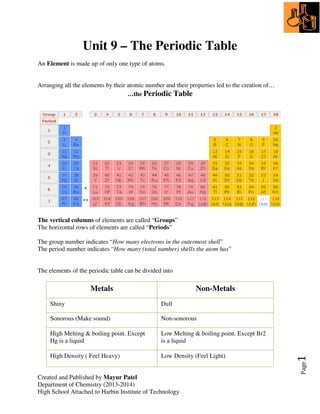
Trends in periodic table (b)
- 1. Created and Published by Mayur Patel Department of Chemistry (2013-2014) High School Attached to Harbin Institute of Technology Page1 Unit 9 – The Periodic Table An Element is made up of only one type of atoms. Arranging all the elements by their atomic number and their properties led to the creation of… …the Periodic Table The vertical columns of elements are called “Groups” The horizontal rows of elements are called “Periods” The group number indicates “How many electrons in the outermost shell” The period number indicates “How many (total number) shells the atom has” The elements of the periodic table can be divided into Metals Non-Metals Shiny Dull Sonorous (Make sound) Non-sonorous High Melting & boiling point. Except Hg is a liquid Low Melting & boiling point. Except Br2 is a liquid High Density ( Feel Heavy) Low Density (Feel Light)
- 2. Created and Published by Mayur Patel Department of Chemistry (2013-2014) High School Attached to Harbin Institute of Technology Page2 Strong Not Strong Malleable (Changed into sheets) Not Malleable Ductile (Changed into wires) Not Ductile Conduct Heat Do not conduct Heat Conduct Electricity Do not Conduct Electricity (Except. Graphite) Classification of Elements in the Periodic Table
- 3. Created and Published by Mayur Patel Department of Chemistry (2013-2014) High School Attached to Harbin Institute of Technology Page3 Define the following: Atom …………………………………………………………………………………………………………………………………………… Element ………………………………………………………………………………………………………………………………………… Halogen………………………………………………… an example of one is __________ (___) Nobel Gas ………………………………………… an example of one is _________ (____) Compound ………………………………………… an example of one is _________ (____) In the Periodic Table……… Reaction Reactants Products Chemical Properties 反应 反应物 产物 化学性质 Physical Properties Tendency Valence electrons Solution 物理性质 趋势 价电子 溶液
- 4. Created and Published by Mayur Patel Department of Chemistry (2013-2014) High School Attached to Harbin Institute of Technology Page4 Trends in Group 1 – The alkali metals They are all metals and Mono-atomic 1) All elements have 1 electron in the outer shell: Eg: Li: 2,1 Na: 2,8,1 K: 2,8,8,1 etc 2) So they tend to loose electrons and form +1 ions (Cations) Eg: are Li+ , Na+ , K+ etc. 3) All elements are Shiny, Light in weight & Soft (Li, Na & K are very soft that can be cut with knife) 4) The melting point of Group I elements decreases down the group. Element Atomic number Melting point (o C) Lithium 3 180 Sodium 11 98 Potassium 19 63 Rubidium 37 39 Casesium 55 29
- 5. Created and Published by Mayur Patel Department of Chemistry (2013-2014) High School Attached to Harbin Institute of Technology Page5 5) Reaction of Group I elements with water 2Li (s) + 2H2O (l) 2LiOH (aq) + H2 (g) 2Na + 2H2O 2NaOH + H2 K + __________________________________ Rb + _________________________________ All of them react vigorously with water giving hydrogen gas and an alkaline solution of the hydroxide. More difficult to loose electron so less reactive More easy to loose electron So more reactive
- 6. Created and Published by Mayur Patel Department of Chemistry (2013-2014) High School Attached to Harbin Institute of Technology Page6 Trends in Group 7 – The Halogens They are nonmetals and Diatomic 1) All elements have 7 electrons in the outer shell: F: 2,7 Cl: 2,8,7 Br: 2,8,18,7 etc. 2) So they tend to gain electrons and form -1 ions (Anions) Eg: are F- , Cl- , Br- etc. 3) PHYSICAL STATE COLOR Fluorine Gas Yellow Chlorine Gas Green Bromine Liquid Brown Iodine Solid Black 4) The melting point of Group 7 elements increases down the group. Element Atomic number Melting point (o C) Fluorine 9 -220 Chlorine 17 -101 Bromine 35 -7 Iodine 53 113 C L O R I N E
- 7. Created and Published by Mayur Patel Department of Chemistry (2013-2014) High School Attached to Harbin Institute of Technology Page7 5) Displacement reaction of Halogens A more reactive Halogen will DISPLACE a less reactive Halogen from a solution of its salt. This is called Displacement Reaction. More easy to gain electron So more reactive More difficult to gain electron So less reactive
- 8. Created and Published by Mayur Patel Department of Chemistry (2013-2014) High School Attached to Harbin Institute of Technology Page8 The Transition Metals
- 9. Created and Published by Mayur Patel Department of Chemistry (2013-2014) High School Attached to Harbin Institute of Technology Page9 The compounds of transition elements have different charges. e.g. Iron can be Fe2+ or Fe3+ , Copper can be Cu+1 or Cu+2 Manganese can be Mn+1 , Mn+2 ......... Mn+7 Red Orange Yellow Turquoise Blue Purple Co(NO3)2 K2Cr2O7 K2CrO4 NiCl2 CuSO4 KMnO4 Many of the transition elements and compounds are used as CATALYSTS. Catalyst: A catalyst is a substance that increases the rate of reaction without taking part in the reaction
- 10. Created and Published by Mayur Patel Department of Chemistry (2013-2014) High School Attached to Harbin Institute of Technology Page10 The Noble Gases/ Inert Gases All of them are UNREACTIVE! Because they have no tendency to loose or gain electrons! Element Uses He Used in Baloons Ne Used in advertising signs and car lights Ar Used in Bulbs Used in welding
